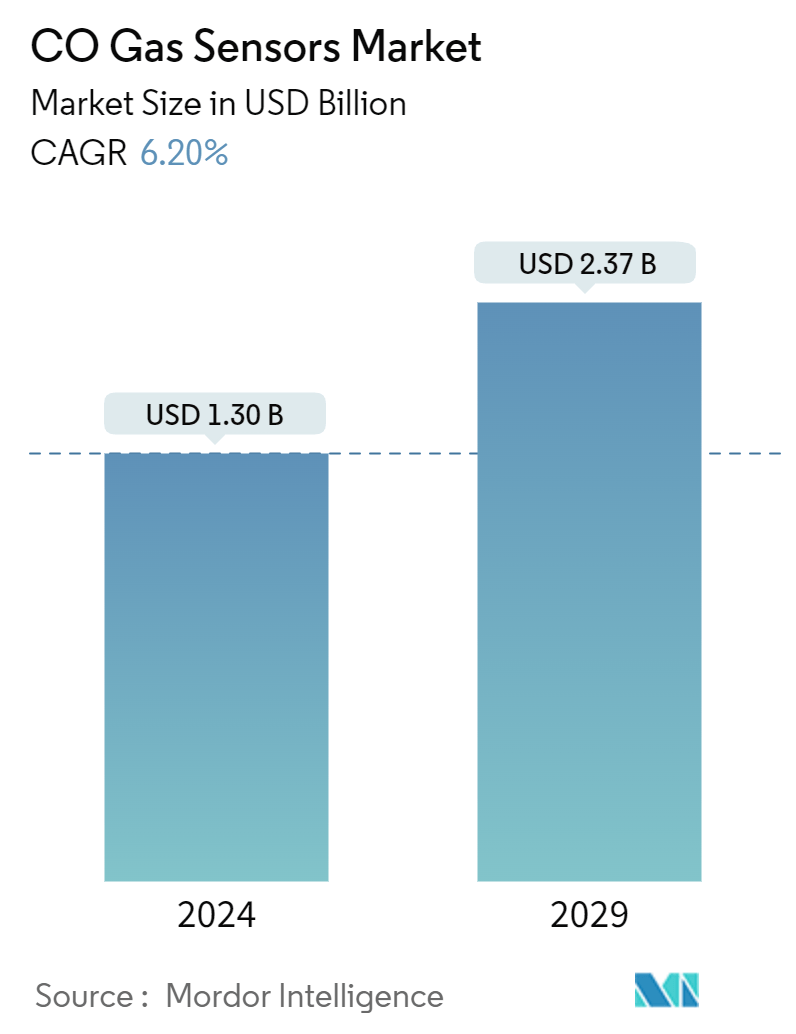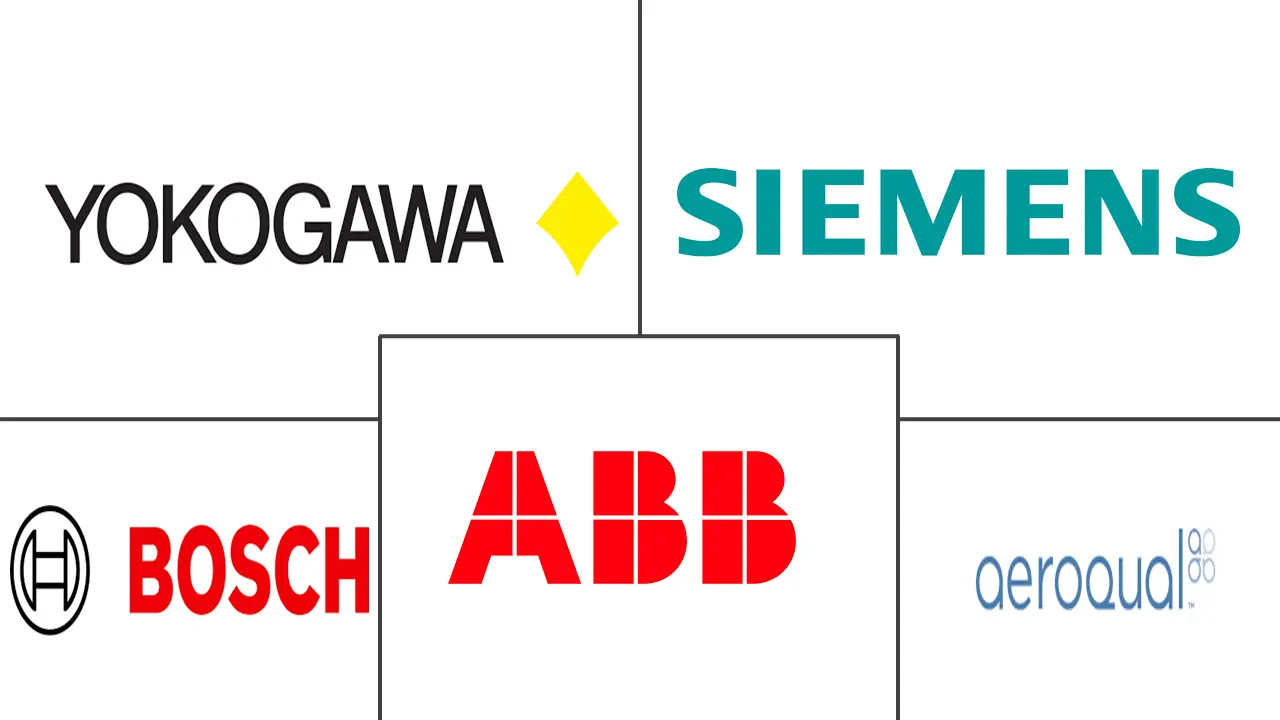Market Size of CO Gas Sensors Industry

| Study Period | 2019 - 2029 |
| Market Size (2024) | USD 1.30 Billion |
| Market Size (2029) | USD 2.37 Billion |
| CAGR (2024 - 2029) | 6.20 % |
| Fastest Growing Market | Asia Pacific |
| Largest Market | North America |
Major Players
*Disclaimer: Major Players sorted in no particular order |
Carbon Monoxide Gas Sensors Market Analysis
The CO Gas Sensors Market size is estimated at USD 1.30 billion in 2024, and is expected to reach USD 2.37 billion by 2029, growing at a CAGR of 6.20% during the forecast period (2024-2029).
Industries have different applications, with some industries using CO gas for their process-related works and other sectors releasing it as a byproduct. To ensure a secure working environment and avoid any life-threatening exposure to the workers, stringent regulations are followed in the industries. These regulations have been critical in the high-paced and early adoption of CO gas alarms and detectors. Thus, this has directly impacted the increased demand for CO gas sensors in industries.
These sensors play a vital role in safeguarding human lives by providing early warnings when carbon monoxide levels rise to hazardous concentrations. These sensors enable swift evacuation and intervention by alerting people to potential dangers and preventing carbon monoxide poisoning and fatalities.
Government regulations to ensure workplace safety primarily increase the growth of the carbon monoxide gas sensors market. For instance, the United Kingdom, Germany, and France have all implemented various rules to avoid the release of dangerous gasses into the atmosphere. Chemical industrial gasses are employed at low flashpoints with lower explosive limits (LEL) and a broad flammable/combustible spectrum. On the other hand, hazards induced by such gases can be minimized by continually using these gas sensors and monitors.
Additionally, the IIoT is advancing in various regions. Customers are becoming more interested in IoT carbon monoxide gas detectors, and players in the enterprise are working on launching a product range tailored to IoT solutions. The necessity for wireless sensors owing to the requirement of constant and real-time monitoring and detection of emissions is anticipated to drive up demand for CO gas detectors in the coming years.
Further, product miniaturization has helped develop portable gas sensor devices that provide carrying flexibility. In these industries, there is a high focus on adopting automation and collecting all the data. Such a requirement has resulted in increased demand for wireless sensors that are enabled with two-way communication features.
However, the absence of regulatory requirements limits market growth as the urgency to adopt these sensors decreases. CO gas sensors have improved significantly, but there are certain technological limitations. For example, some sensors have difficulty detecting low levels of carbon monoxide, have a limited lifespan, and require frequent calibration. These technical limitations are expected to hinder the carbon monoxide gas sensor market.
Additionally, the Russia-Ukraine war is impacting the supply chain of semiconductors and electronic components, being a significant supplier of raw materials for producing semiconductors and electronic components, including sensors. The dispute has disrupted the supply chain, causing shortages and price increases for these materials, impacting carbon monoxide (CO) gas sensor manufacturers and potentially leading to higher costs for end users.
Carbon Monoxide Gas Sensors Industry Segmentation
Carbon monoxide (CO) gas sensors are used in industries and at home to detect the concentrations of CO in the air. These sensors also output the reading as an analog voltage, triggering an alarm or providing a visual indication based on other complementing features.
The carbon monoxide gas sensors market is segmented by technology (semiconductor sensor, electrochemical sensor, solid state/MOS sensor, PID, catalytic, and infrared), application (medical, petrochemical, building automation, industrial, environmental, automotive, and other applications), and geography (North America, Europe, Asia-Pacific, Latin America, and Middle East and Africa). The market sizes and forecasts are provided in terms of value (USD) for all the above segments.
| By Technology | |
| Semiconductor Sensor | |
| Electrochemical Sensor | |
| Solid State/MOS Sensor | |
| PID | |
| Catalytic | |
| Infrared |
| By Application | |
| Medical | |
| Petrochemical | |
| Building Automation | |
| Industrial | |
| Environmental | |
| Automotive | |
| Other Applications |
| By Geography*** | |
| North America | |
| Europe | |
| Asia | |
| Australia and New Zealand | |
| Latin America | |
| Middle East and Africa |
CO Gas Sensors Market Size Summary
The carbon monoxide gas sensors market is poised for significant growth, driven by stringent safety regulations and the increasing need for workplace safety across various industries. These sensors are crucial for detecting hazardous levels of carbon monoxide, thereby preventing potential poisoning and fatalities. The market is experiencing a surge in demand due to the adoption of advanced technologies like the Industrial Internet of Things (IIoT), which facilitates real-time monitoring and detection of emissions. The miniaturization of sensors has also led to the development of portable devices, enhancing flexibility and ease of use in diverse industrial applications. However, the market faces challenges such as technological limitations in sensor detection capabilities and the impact of geopolitical events like the Russia-Ukraine war, which has disrupted supply chains for essential components.
Regionally, North America is expected to be a lucrative market due to substantial investments in research and development of environmentally friendly products and stringent regulations mandating the installation of CO gas sensors. The increasing incidence of CO poisoning incidents has further fueled demand in this region. Globally, the LPG and LNG sectors are rapidly adopting these sensors to ensure safety during gas storage and transportation. The petrochemical industry also drives demand, with sensors being essential for monitoring gas levels in processes like oil recovery and chemical production. The market is semi-consolidated, with major players innovating to meet regulatory standards and enhance sensor technology. Recent developments include Honeywell's local assembly initiative in Saudi Arabia and ABB's collaboration with Imperial College, highlighting the industry's focus on localization and technological advancement.
CO Gas Sensors Market Size - Table of Contents
-
1. MARKET INSIGHTS
-
1.1 Market Overview
-
1.2 Industry Value Chain Analysis
-
1.3 Industry Attractiveness - Porter's Five Forces Analysis
-
1.3.1 Threat of New Entrants
-
1.3.2 Bargaining Power of Buyers
-
1.3.3 Bargaining Power of Suppliers
-
1.3.4 Threat of Substitute Products
-
1.3.5 Intensity of Competitive Rivalry
-
-
1.4 Impact of Macroeconomic Trends on the Market
-
-
2. MARKET SEGMENTATION
-
2.1 By Technology
-
2.1.1 Semiconductor Sensor
-
2.1.2 Electrochemical Sensor
-
2.1.3 Solid State/MOS Sensor
-
2.1.4 PID
-
2.1.5 Catalytic
-
2.1.6 Infrared
-
-
2.2 By Application
-
2.2.1 Medical
-
2.2.2 Petrochemical
-
2.2.3 Building Automation
-
2.2.4 Industrial
-
2.2.5 Environmental
-
2.2.6 Automotive
-
2.2.7 Other Applications
-
-
2.3 By Geography***
-
2.3.1 North America
-
2.3.2 Europe
-
2.3.3 Asia
-
2.3.4 Australia and New Zealand
-
2.3.5 Latin America
-
2.3.6 Middle East and Africa
-
-
CO Gas Sensors Market Size FAQs
How big is the CO Gas Sensors Market?
The CO Gas Sensors Market size is expected to reach USD 1.30 billion in 2024 and grow at a CAGR of 6.20% to reach USD 2.37 billion by 2029.
What is the current CO Gas Sensors Market size?
In 2024, the CO Gas Sensors Market size is expected to reach USD 1.30 billion.

